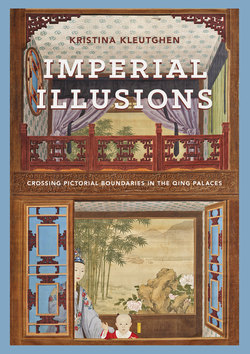Читать книгу Imperial Illusions - Kristina Kleutghen - Страница 93
На сайте Литреса книга снята с продажи.
Оглавлениеmany sons to carry on the family line, while the lanterns also suggest the traditional theme of a New Year’s image celebrating the lantern festival.69 Nian divides this image into six layers (ceng) of overlapping images, each with the same eponymous grid (quadro) that aided the European quadraturisti in transferring their original cartoons to walls.70 The implication of Nian’s grid is that the contents of each image layer corresponded with various squares in the grid and could therefore be recreated simply by scaling the contents of any given square in the grid onto a larger square.
Each image occupies progressively less space relative to the layer that precedes it. An elaborate architectural frame provides the frontmost layer of the complete, ungridded view, and the five layers behind it show the different groupings of figures, each smaller than the one before, which recede into the background one lateral slice at a time. Each individual layer of the image shows only the figures and objects occupying that single slice of the spatial construction. The figures and objects in a given layer are therefore of a consistent size, respectively either larger or smaller than those that follow or precede them. This multipart illustration suggests that the procedure for creating such a richly detailed image requires both the firm structure of a grid and the spatial awareness to identify the various layers of an image in order to produce a view that successfully appears to recede into the distance. However, Nian’s accompanying commentary is frustratingly incomplete: “These picture-layers are piled up in the spatial recession method [yuanjin zhi fa, literally ‘method of nearness and distance’]. The above five pictures are clear and will not be discussed further. When painting people in spatial recession, you can take the sizes of the six layers as your models.” These techniques were far from common knowledge, and Nian challenges his readers by assuming that they could fully understand the visual instructions without his explaining either the picture or the unusual procedure required to reproduce it.
On the next page of illustrations, which continues the explanation of this process and its outcome, Nian uses an oblique view of this layer system to expand on how to depict figures in a receding perspectival space (figure 2.13). The five example images all depict the same scene: three children, each holding toys such as a fish on the top of a stick or a pointed lotus dangling from another stick, are sketched out under a canopied ceiling, similar to the content on the previous page. The individual images are again gridded, but also now numbered along both the horizontal and vertical axes. Each increasingly smaller image has progressively larger margins to indicate the growing area overlapped by the image above it according to Nian’s layering method. The brief text accompanying this page explains how to create this type of image by placing sequentially smaller figures in each layer as on the previous page, and concludes with Nian’s comment that “if you use this method to paint, your paintings will possess the same marvelous deep recession as in nature.” Although Nian does not explain exactly what “this method” is, careful examination of the images reveals it: regardless of the size of the individual images relative to the complete composition, the figures and objects always occupy the same number of
